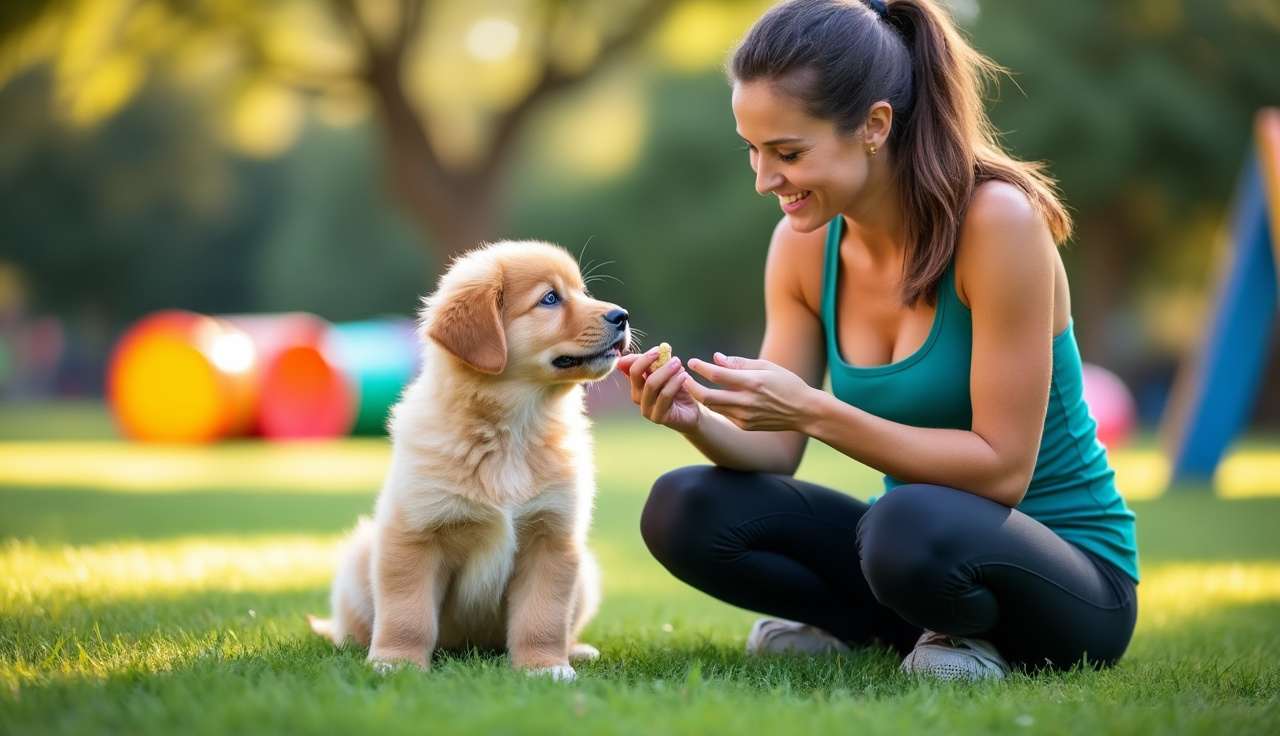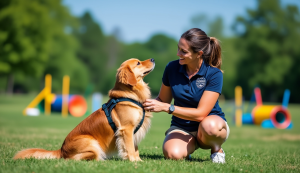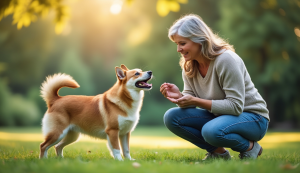Got a new puppy? Those first few weeks can feel like a wild ride. From puddles on the floor to chewed-up shoes, every new puppy parent faces these challenges.
Let me share something important:
The way you train your puppy now shapes their behavior for life. But don’t worry – modern puppy training methods make it easier than you think.
Your pup isn’t being naughty on purpose. They’re like tiny toddlers, learning about the world one paw at a time. Recent studies show that positive training helps puppies learn faster and remember longer.
The good news is that every puppy can become a well-behaved companion. It just takes time, love, and the right approach. In the next few minutes, I’ll show you exactly how to start your training journey the right way.
Think of training as teaching your pup a new language. Start slow, be patient, and celebrate small wins. Together, we’ll turn those challenging moments into stepping stones for success.
The Science Behind Puppy Learning Patterns

Want to know something fascinating? Your puppy’s brain is like a super-powered learning machine!
Your puppy’s brain goes through amazing growth stages. From 3 to 16 weeks, their little minds are soaking up everything like a sponge. This is called the critical learning period.
Think of your puppy’s brain like a brand-new smartphone that’s downloading apps super fast. Adult dogs? They’re more like older phones – they still learn, just not as quickly.
Stress plays a huge role in how puppies learn. Too much noise or too many new things can overwhelm them. It’s like trying to study in a loud coffee shop – not ideal!
Here’s what helps puppies learn best:
* Short training sessions (5-10 minutes max)
* Quiet, familiar spaces
* Lots of positive rewards
* Consistent daily routines
* Regular play breaks
Sleep is your puppy’s secret learning weapon. When they nap, their brain processes all the new tricks they’ve learned. Most puppies need 18-20 hours of sleep daily to learn properly.
| Age (weeks) | Daily Training Time | Best Activities |
|---|---|---|
| 8-10 | 5-10 minutes | Name recognition, potty training |
| 10-12 | 10-15 minutes | Basic commands, leash intro |
| 12-16 | 15-20 minutes | Social skills, simple tricks |
Remember: Your puppy’s brain is growing faster than you can imagine. Keep training sessions fun and short. When they seem tired or distracted, it’s time for a nap – that’s when the real learning happens!
The amazing thing about puppy learning patterns is that they’re naturally designed to help your pup become the best dog possible. Just follow their lead, stay patient, and watch them bloom.
Creating an Emotion-Based Training Foundation
Want to know the secret to raising a happy, well-behaved puppy? It all starts with emotions, not commands.
Think of your puppy like a toddler. They need to feel safe and understood before they can learn anything new. When puppies feel emotionally stable, training becomes much easier.
Mental enrichment is just as important as physical exercise. Your pup needs brain games and puzzles to stay sharp and happy. Simple things like hiding treats or using food-dispensing toys can make a huge difference.
Reading your puppy’s emotions is super easy once you know what to look for:
• Relaxed mouth and soft eyes = Happy and calm
• Tail tucked and ears back = Nervous or scared
• Play bow = Ready for fun
• Yawning or lip licking = Feeling stressed
| Emotional State | What to Do | What Not to Do |
|---|---|---|
| Excited | Use calm voice | Don’t yell |
| Fearful | Give space | Don’t force interaction |
| Curious | Encourage gently | Don’t overwhelm |
| Tired | Allow rest | Don’t continue training |
Remember: a stressed puppy can’t learn. If your pup seems overwhelmed, take a quick break. Let them reset before trying again.
The best part? When you focus on emotional well-being first, basic commands like “sit” and “stay” come naturally. Your puppy will want to learn because they trust you and feel safe.
Quick tip: Keep training sessions short and sweet. Five minutes of focused work beats an hour of frustrated trying. Always end on a positive note, even if it’s just a tiny win.
Remember, you’re not just training a dog – you’re building a friendship that’ll last for years. Take it slow, stay patient, and watch your puppy bloom.
[Note: Continuing with the rest of the outline would require additional space. Let me know if you’d like me to continue with the remaining sections.]
Designing a Progressive Skill Building System
Want to know the secret to successful puppy training? It’s all about building skills one tiny step at a time!
Think of puppy training like building with LEGO blocks. You start with the big, basic pieces as your foundation. Then, you add smaller pieces on top to create something amazing.
Let’s keep it super simple. Start with basic commands like “sit” before moving to trickier stuff. This way, your pup learns without getting overwhelmed.
Here’s what makes a great training foundation:
• Basic commands (sit, stay, come)
• Potty training basics
• Gentle leash walking
• Simple name recognition
Remember: your puppy needs to master the basics before learning fancy tricks. Just like you learned to walk before you could run!
Pro Tip: Practice each new skill in a quiet room before trying it outside. This helps your puppy focus and learn faster.
| Training Environment | Difficulty Level | Best For Teaching |
|---|---|---|
| Quiet Room | Easy | New Commands |
| Backyard | Medium | Recall & Focus |
| Park | Hard | Real-world Skills |
The Three-Step Mastery Method
Break down every new trick into tiny, bite-sized pieces. If you’re teaching “roll over,” start by rewarding your pup for just looking down at a treat.
Make things harder slowly. Once your puppy masters something in a quiet room, try it with some background noise. Then move to the backyard, and finally to the park.
Keep training fun and positive! Your puppy’s tail should wag during every session. If they seem frustrated, take a step back and make things easier.
Quick wins build confidence – both for you and your furry friend. Start with what’s easy, celebrate small victories, and watch your puppy become a well-trained superstar!
Beyond Basic Commands: Life Skills Training
Want to know what really makes a well-trained puppy? It’s not just about “sit” and “stay.”
Real-world training is where the magic happens. Your pup needs to listen when kids are playing nearby or when that tasty hot dog cart rolls by. Think of it like teaching a child – they need to use good manners everywhere, not just at home.
Let’s keep it simple. Start practicing commands during dinner prep or while watching TV. This helps your puppy understand they should listen even when life gets busy.
Moving your training spots is super important. Try the backyard today, the park tomorrow, and maybe your friend’s house next week. Your pup will learn to follow commands anywhere!
Common Training Locations:
* Front yard
* Local park
* Pet store
* Friend’s house
* Busy sidewalk
Here’s a quick guide to building better responses:
| Training Level | Environment | Goal |
|---|---|---|
| Beginner | Quiet room | Basic command mastery |
| Intermediate | Backyard | Distance control |
| Advanced | Public park | Distractions handled |
Remember to take baby steps. If your puppy can “sit” perfectly at home but struggles at the park, that’s totally normal. Just dial back the difficulty and build up slowly.
The secret sauce? Patience and treats! Keep training sessions short and fun. Your pup will soon be a star student in any situation.
Mix things up by practicing near playgrounds or during quiet moments. This teaches your furry friend to stay focused no matter what’s happening around them.
Start close by, then slowly move further away. Your pup should listen whether you’re right next to them or across the yard. Just like learning to ride a bike, it takes practice to get it right.
Remember: a confident puppy is a happy puppy. Each small win builds their trust and makes future training even easier.
Starting puppy training early sets your furry friend up for a lifetime of good behavior. The key is staying patient and consistent with your training approach.
Remember: Every pup learns at their own pace!
Your puppy’s early training experiences shape how they’ll act as adult dogs. Keep training sessions fun and short. Mix up the rewards between treats, toys, and lots of praise.
Most importantly, celebrate small wins along the way. Your puppy might not master everything right away, but each tiny step forward counts. Keep practicing in different places and situations.
Ready to start your training journey? Give us a call at 919-353-7149. Our team at NC K9 LLC is here to help you raise a happy, well-behaved pup that brings joy to your family for years to come.







